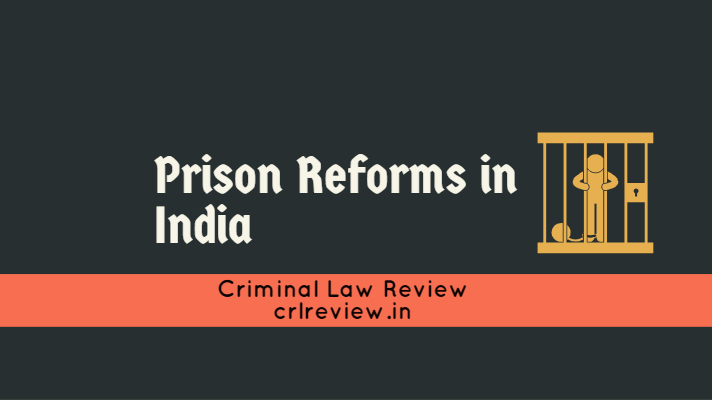Description

Copyright infringement not intended
In News
- The Minister of State for Home Affairs informed the Rajya Sabha about the funds released by the Ministry of Home Affairs (MHA) to the States and Union Territories (UTs) for strengthening the ‘e-prisons’ portal, intended for prison computerisation; and in connection with ‘modernisation of prisons’ for enhancing the security infrastructure in prisons, etc.
Prison in pre-Independent India
- In 1935, Macaulay's Minute laid down the foundations of the Prison system in India.
- In 1938, a Prison Discipline Committee rejected the humanitarian needs of the prisoners.
- The Prison Acts of 1861 and 1894 formed the basis for the present jail management and administration.
- In 1919-1920, for the first time in India's colonial history, the Indian Jail Committee declared reform and rehabilitation as the objectives of the Prison administration.
- The Government of India Act of 1935 transferred the subject matter of "prisons" from the Central list to the State list. After-Independence, Indian Constitution also kept the prison under the “State list”.
- It resulted in non-uniformity in Prison laws and management across the various States of India.
- Modern Prisons in India are a legacy of British rule.
.jpg)
Prison in Independent India
- In 1960, All-India Jail Manual Committee prepared a Jail Manual. This forms the bedrock of Prison management in modern India.
- In 1972, the Group appointed by the Union Home Minister recommended designing a National Policy on Prisons.
- In 1983, Justice Mulla's committee reviewed the laws, rules, and regulations for protecting society and reforming offenders. The Committee suggested several reforms;
- Government to provide dignified living Conditions for Prisoners and focus more on security aspects.
- In 1987, The Justice Krishna Iyer Committee highlighted the difficulty of women prisoners and emphasized the need to induct more women into the Police Services and management to inculcate a gender-sensitive approach in prison management.
- Supreme Court from time to time has taken a reformative approach in many significant judgments giving a boost to the discourse on prison reforms. Important directives by the Supreme court:
- Prisoners have some human rights, but inside the jail, only the right to liberty is curtailed. However, they are entitled to other fundamental rights.
- The state is duty-bound to ensure that the right to free legal aid under Article 39A is made available to the prisoner.
- Handcuffing is prima facie an inhumane practice.
- Prisoners are entitled to minimum wages for the work done inside the prison.
Challenges in Indian Prison System
- Existing prison infrastructure is inadequate resulting in overcrowding.
- The unsatisfactory living conditions affect every aspect of inmates' daily existence such as food, cleanliness, etc.
- Abuse of authority by the staff sometimes takes unfair advantage of the prisoner's dependency.
- Custodial deaths
- According to the latest available data released by the National Crime Records Bureau (NCRB) for 2020, about 76% of all prisoners in India are undertrials.
- Availability of drugs, and access to mobile phones.
- Overcrowding, Unhygienic Conditions.
- Lack of infrastructure, inadequate facilities.
- Inadequacy of female Staff
- Understaffing and Underfunding:
- 33% of the total requirement of Prison officials Still lies vacant.
- In the absence of adequate Prison Staff, overcrowding of Prisons leads to violence and other Criminal activities inside the Jails.
- Judicial Pending in various Courts.
- Unnecessary arrests.
- The majority of Prisoners are Under Trials
- Restricted access to legal representatives
- Lack of Proper Medical Care, Constant danger of exploitation and torture
- Lack of legal aid, Sanitation, unhygienic food and Health Problems.

Way forward
- The most important challenge that arises from both the human rights perspective and the internal security point of view is the upgradation of infrastructure. This can be done through improvement in budgetary allocations to the prison establishments.
- Prisons are a state subject; this creates difficulty in having uniform prison management. The Union can only frame models for the states to incorporate and help in coordinating between states, encouraging them to adopt best practices.
- Need to enhance accountability in the administration system.
- Strengthen Surveillance and Grievance Redressal mechanisms.
- The Supreme Court advised the centre that criminals sentenced to imprisonment for 6 months or a year should be allocated social service duties rather than be sent to further choke the already overflowing prisons.
- Ensure adequate availability of medical assistance, Psychological Counseling.
- Allowing undertrials on Personal bonds to leave jails.
- The need of the hour is to design a National Policy on Prisons and ensure Proper implementation of the model jail manual,
- Conduct training and Sensitization Programmes for Senior Police officers of all Prisons.
- Alternative methods should be used for dealing with non-criminal offenders and petty criminals.
- Adopt Semi-open Prisons or open Prisons (allow convicts to work outside the jail and earn a livelihood and return in the evening) system to reduce overcrowding.
- Many important Committees have been set up to review the situation of prisons in India and suggest reforms. However, the implementation of the reforms has been lax and the necessary political will are required to bring change to the present system of prison management in India.
https://pib.gov.in/PressReleasePage.aspx?PRID=1885485
















